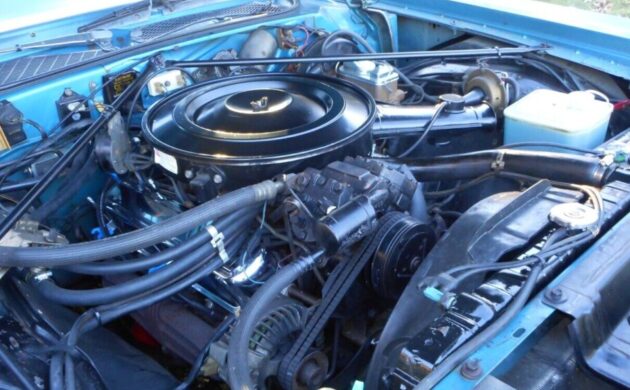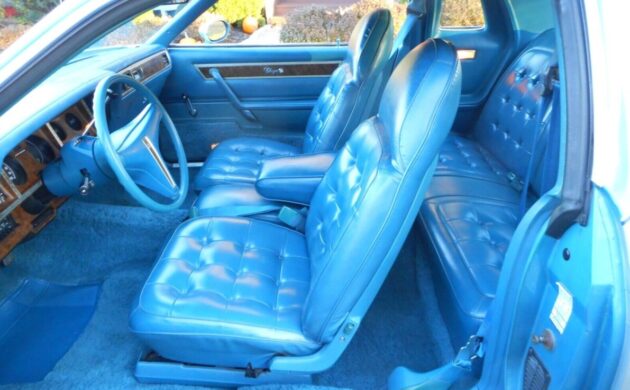A 1975 Charger Daytona, really? Yup! Most associate the Daytona name with the slope-nosed, high-tailed NASCAR terror from 1969, a one-and-done model. But unbeknownst to me, the Daytona nameplate resurfaced on the 1975 Charger SE, and for your review, we have one featured here today. Located in Chester, New York, this extra special Charger SE is available, here on eBay for a current bid of $10,200 with the reserve not yet met.
Dodge’s mid-size line-up did some moving around in 1975. The traditional Charger was ostensibly replaced by the recently returned Coronet two-door hardtop, while Chrysler’s Cordoba, rebadged as a Dodge and wearing different taillights, stood in for the new Charger SE. Motales.com had this to say about the reconstituted Daytona, “The new Charger Daytona was not quite the same creature. The main way to tell it from a Charger SE was the two-tone paint scheme, which was bright and attractive; the car also had accent stripes, decals, and vinyl bucket seats. This could not be mistaken for a stock Cordoba, but it really wasn’t a Charger Daytona, either. The new $132 package was launched in March 1975, with three color combinations…” Besides the two-tone paint scheme, the Daytona also featured, badging and tape stripes, racing mirrors, a painted grille, bucket seats, a center armrest, shag carpet (oooh yeah!), front and rear anti-sway bars, a digital clock, power steering, and power front disc brakes. Full wheel covers were standard but urethane-styled wheels were an option.
Standard Charger SE/Daytona power was provided by a 180 net HP, 360 CI V8 engine, working through a TorqueFlite, three-speed automatic transmission. The seller states, “Vehicle runs and drives extremely well. This car is a true pleasure to drive.” The only modification appears to be the inclusion of a dual exhaust system. Interestingly, unlike other domestic manufacturers, Dodge/Chrysler did not employ catalytic converters in ’75, instead commencing them with the ’76 models. A mileage recording of only 45K miles is stated, and assuming that it is accurate, this Charger still has a lot of charging to do.
The exterior is as perfect as new and the seller mentions, “Vehicle has always been in a collector car environment. It has always been garage kept and never driven in winter months” – it looks it! I’ll admit it, I’m not a fan of two-tone paint jobs and tape stripes but this Charger pulls off the look exceedingly well. The only item that seems out of character is the wheels, they are Mopar road wheels but I don’t believe this version was available on this edition of the Charger SE/Daytona.
Inside, we got a whole lot of blue going on. It shows like new though the seller mentions some minor dash pad cracks. The seats look comfy and that 24-ounce “shag” carpet is just shagging along – it’s clean and not showing any signs of balding.
Dodge produced 30K Charger SEs in ’75 but I couldn’t find a separate Daytona breakout though the seller claims it to be 238 which I guess is a reasonable count for a first-year, late (March) intro model – and the fact that it’s really just an appearance package. Things by ’75 had certainly changed dramatically since the Daytona’s 1969 introduction – and it wasn’t just at Dodge. All manufacturers now had a bevy of regulations and changing tastes to manage. This car’s value is likely due to its limited production volume and overall superior condition more so than what it existentially is – and those items are what I bet will ultimately be this car’s selling features. Assuming of course, that the reserve is reasonable, right?







I was an engineer at the Windsor Assembly plant when this model was in production. It was my favorite, unfortunately I couldn’t afford it. This one looks like it just rolled off the line.
rebadged Cordoba
Beautiful robin egg 🥚 blue interior.
Perfect car to cruise the mean streets of Detroit, out to Auburn Hills, then over to Windsor.
Rode in a new 75 Cordoba and Charger. Nice personal luxury, NOT a Charger. But that’s the result of Ins. companies and Fed. mandates at that time.
Man I hated these (Cordoba’s etc) back in the day. I was driving a ’69 Super Bee (nope not a “Honda Civic”) at the time to help you understand why. But I think it’s beautiful today.
Exactly. I had a 69 Charger 383 Magnum and realized then it was going to be collectible. Now Chargers/Super Bees are thru the roof!
When a vintage vehicle has had a dual exhaust system installed it’s probably because A) it sounds great and helps the engine breathe more efficiently, or B) the crossover pipe is now made of unobtanium.
I had a 75 Dodge Royal Monaco that had a catalyic converter. It was built just before the 76 came out.
OK, good to know because I have found conflicting information doing research. Perhaps some Mopar engines did, and some didn’t?
Is there anyone who can shed some light on this matter?
Thx,
JO
Hi Jim, I read, US mandated all cars to have CCs in 1975, so this should have one, unless it was stolen. CC thefts have skyrocketed in recent years.
Howard:
That was my understanding too. But I have read now, in two different places, one of which was on the referenced motales.com site, that Mopars didn’t make use of CCs until ’76. Agreed, even states with emission inspections generally exempt ’75 and older models.
Thx,
JO
Ran out of time,,how rude,,anyway, I was babbling about, how many states that require exhaust testing, vehicles this old are exempt, so a replacement exhaust, as seen here, probably won’t have a CC.
OK, here’s a page from the 1975 Dodge Monaco brochure (not the Charger but the same 360 CI engine) and it does reference a catalytic converter, so I guess they were in use at Mopar that year.
JO
I bought a new 49 state Toyota SR5 Longbed brand new
in Oregon,& it came without a converter.
Howard, I think you are right. Many a car from this era ran “test” pipe sections in place of the dreaded CC. Freed up the exhaust for better MPG and power output. Such hypocrisy. They were advertised to only be used for long enough to see if you CC was “plugged” and needed to be replaced. Oh yeah, sure. Funny how they fit your car perfectly and were made much thicker than a supposed throw away piece would have to be. I understand the lure, esp in those days with early primitive emissions robbing cars of the ability to perform and even run smoothly…but we all need to breath. The car makers had a Federal mandate, and they had to start somewhere. The learned as they went along. In my part of the Midwest, there were no annual pollution checks, so these were very popular. Many of my friends used them, but I felt that the air quality trade off was a cause worth supporting.
Hi Grant, the “test pipe”,,HA! That inventor is on a South sea island somewhere. Another trick was knock the guts out of the converter, and slip a straight piece of pipe through it. Some testing places actually checked to see if a converter was in place, naturally, it wouldn’t pass, but maybe on a commie roadside check you’d get by. Just like the “air pumps” years ago. All they did was inject fresh air into the exhaust, diluting the emissions some, but not any cleaner. This DEF baloney for diesels, another fleecing. My MGB had an air pump, ran terrible. Back fired, high idle, then one day, that all stopped, it ran great and idled. Turns out the pump froze breaking the belt. Not uncommon.
Nice, I think it was these cars, that young punks( like me) finally grew up, got a decent job, and bought these. It oozes class from every nut and bolt. Fading was the gut wrenching Chargers, to more sedate means. Impressing a future father-in-law, or business associate, aka, a boss, couldn’t go wrong here. A 4 speed, hemi Charger, not so much. These disappeared in ’78, and was reintroduced as a rebadged Omni in ’82,I believe, a sad low for one of Chryslers mightiest of cars. Like that Regal, last of some of, what I consider, the zenith of RWD cars. These suffered all the misgivings of air pollution controls, something all US car makers struggled with, some more than others, but again, like the Regal, automobiles could have stopped right here, and that would’ve been fine with me. Nice car!
Oh wow….that interior gives me The Blues.
One might get seasick in there…..after having a few !
Maybe one of those blue Smurfs owned it. lol
A normal sized person couldn’t reach the breather nut on one of these without stepping beside a fender to do so! Same with the Montes. Crumple zone heaven. My buddy had a blue with black vinyl top 69 Charger with a 383 automatic—POS with bent front fender and “V” pushed in rear bumper and trunklid. We ran it around a tobacco warehouse after school in Glasgow Ky until the engine blew one day. I can still remember driving to school one morning and seeing it on a load of crushed vehicles, all of about 2′ tall. Wish I had gave him the $350 he paid for it and parked in a garage!
I worked for Chrysler back in 1975. As far as I can recall, ALL US car companies had to make their cars with a catalytic converter. Huge reductions in performance took place across all makes and models as a result of this. I am not aware of any Chrysler model built for the US market that did not have a catalytic converter. I’m an old man now and perhaps my memory is not as good as it used to be. So I could be wrong. But I don’t think so.
I may be off-base on this, but wasn’t the lean-burn system developed so that Chrysler wouldn’t need to install a catalytic converter?
IMO, an insult to the Charger(even worse, Daytona) name, & should have been called somethin else – like the late ’70s “Challenger”.
All of these “Personal Luxury Cars” pretty much aped the 1971 Pontiac Grand Prix. But the ’71 GP was by far the best and could not be topped even by future iterations of itself.
Then there’s this Corbtona identity crisis: from screaming on the high banks to genuine Corinthian leather within half a decade’s time. Progress is all too often deeply depressing. Take right now for instance.